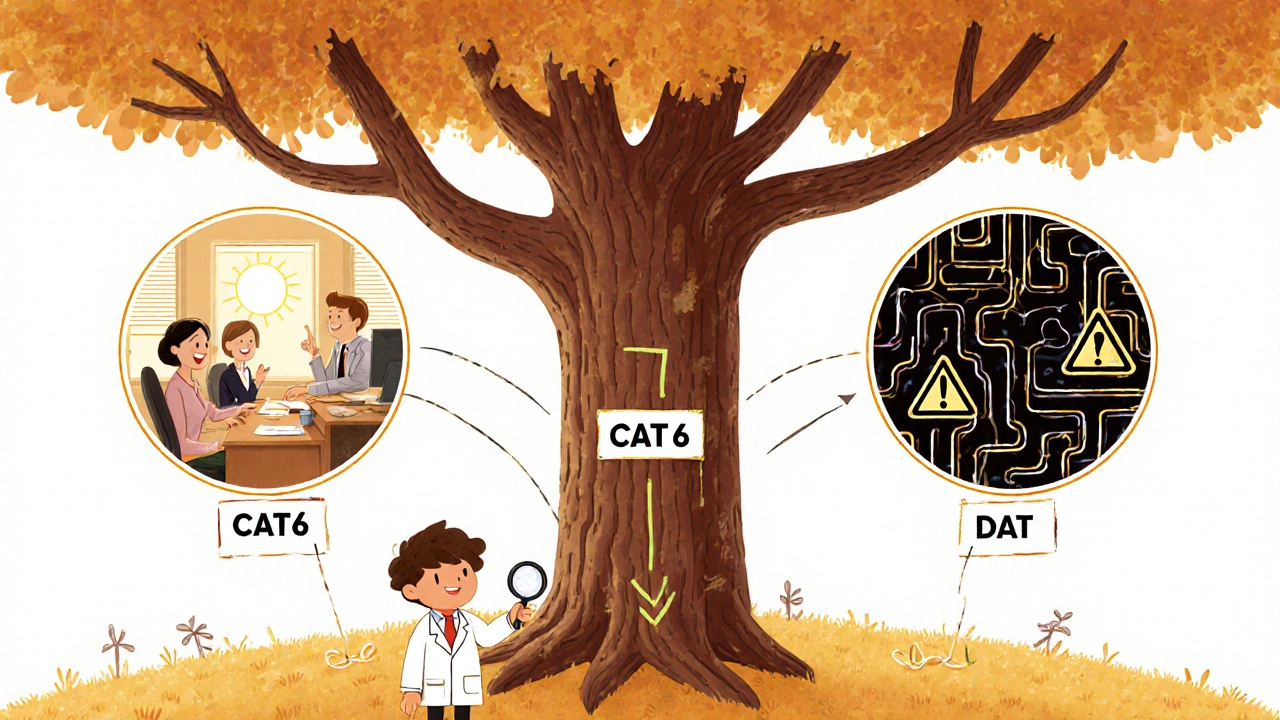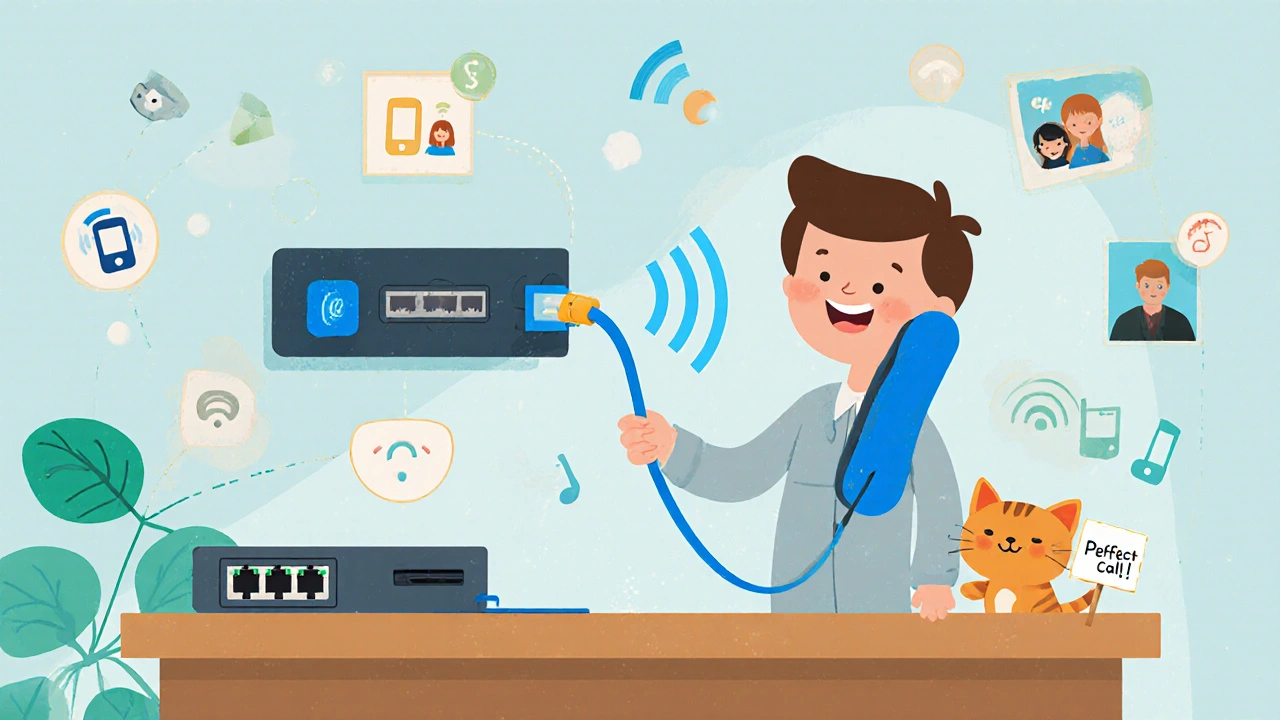Most businesses think VoIP call quality is about the phone system or internet speed. But the real culprit behind crackling calls, dropped connections, or echo? It’s often the cable under your desk. If you’re choosing between CAT6 and CAT7 for your VoIP setup, you’re not just picking wire-you’re picking reliability. And most of the time, you don’t need CAT7.
What’s the real difference between CAT6 and CAT7?
CAT6 and CAT7 are both Ethernet cables, but they’re built for different worlds. CAT6, introduced in 2002, is the workhorse of office networks. It handles up to 1 Gbps at 100 meters and can push 10 Gbps-but only up to 55 meters. It’s usually unshielded (UTP), which means it’s flexible, cheap, and easy to install. Most VoIP phones, even high-end ones, use less than 100 Kbps per call. That’s less than 1% of CAT6’s full capacity.
CAT7, on the other hand, is a different beast. Released in 2010, it’s designed for environments where noise kills signals. It runs at 600 MHz, supports 10 Gbps over the full 100 meters, and wraps each twisted pair in foil, then wraps the whole bundle in a braided shield (S/FTP). That makes it thicker, stiffer, and heavier. It also needs special GG45 or TERA connectors instead of the standard RJ45. You can’t plug a CAT7 cable into a regular switch and expect it to work right-you need compatible hardware.
For VoIP? The shielding matters only if you’re fighting interference. If your office is next to a warehouse with industrial motors, near a power substation, or in a hospital with MRI machines, CAT7’s shielding can reduce packet loss by up to 95%. But in a typical office? It’s overkill.
Why CAT6 is the right choice for 95% of VoIP setups
Let’s say you have a 50-person office with 40 VoIP phones, a few video conferencing units, and a wireless access point. Each phone uses about 85 Kbps on a G.711 codec. That’s 3.4 Mbps total for voice. Even with video calls and file transfers running, you’re still under 100 Mbps. CAT6 handles that with room to spare.
Network engineers at Spiceworks and Reddit have reported years of flawless VoIP performance on CAT6. One admin in a 50-person company said his jitter stayed under 15ms and packet loss was below 0.1% for three years-no drops, no static. That’s not luck. That’s CAT6 doing its job.
CAT6 also supports PoE+ (802.3at), which delivers up to 30 watts. That’s enough for most VoIP phones with HD audio, Bluetooth, and color screens. You don’t need the 60-100 watts of PoE++ (802.3bt) that CAT7 enables-unless you’re powering a full video conferencing system with cameras and speakers over the same cable. And even then, you might be better off using a separate power adapter.
Cost is another big factor. CAT6 cable costs 25-40% less than CAT7. Termination? CAT6 uses standard RJ45 connectors and tools anyone with basic training can handle. CAT7 requires specialized tools, grounding techniques, and more time. One field study found CAT7 installation took 25% longer than CAT6. That’s extra labor, extra risk, extra cost.
When CAT7 actually makes sense for VoIP
There are cases where CAT7 isn’t just nice-it’s necessary.
Take a manufacturing plant. Heavy machinery, welding stations, and variable frequency drives create massive electromagnetic interference (EMI). One IT director on Reddit switched from CAT6 to CAT7 in her factory office after VoIP calls kept dropping. Her Mean Opinion Score (MOS)-a measure of voice quality-jumped from 3.2 (poor) to 4.5 (good). That’s the difference between employees complaining about calls and actually using the system.
Same goes for data centers, financial trading floors, or medical imaging rooms. If your network runs alongside high-voltage equipment, CAT7’s shielding prevents crosstalk and signal degradation. It’s also the only choice if you need consistent 10 Gbps over 100 meters for future-proofing-say, if you’re deploying a unified communications platform like Microsoft Teams Phone System that combines voice, video, and screen sharing.
But here’s the catch: CAT6a (augmented CAT6) exists. It runs at 500 MHz and supports 10 Gbps at 100 meters-same as CAT7-without the shielding complexity or connector headaches. Many enterprises now choose CAT6a over CAT7 because it hits the same performance target at half the cost and with standard RJ45 plugs.

Installation nightmares with CAT7
CAT7 isn’t just expensive-it’s a pain to install. Its thick, shielded design makes it stiff. Trying to route it through tight conduits or existing cable trays? You’ll need more time, more force, and more patience. One network technician on Stack Exchange said CAT7 installation took 30% longer than CAT6 just because of the rigidity.
And grounding? If you don’t ground the shield properly, you create ground loops-which can actually make signal quality worse. Fluke Networks warns that improper grounding is one of the top causes of intermittent VoIP issues in CAT7 deployments. Most IT teams don’t have the training. BICSI’s certification program says CAT7 needs an extra 15-20 hours of training beyond CAT6.
Testing tools? Standard network testers work with CAT6. For CAT7, you need adapter modules that cost $150-$300 each. That’s not something you keep in your tool kit unless you’re doing nothing but CAT7 installs.
Market reality: CAT6 dominates for a reason
Vertical Systems Group’s 2023 report shows CAT6 is used in 78% of new business VoIP installations. CAT7? Just 8%. Even in Europe, where CAT7 is more common, CAT6a is eating into its share.
Why? Because businesses aren’t dumb. They look at the numbers. The cost of CAT7 doesn’t buy better call quality-it buys peace of mind for environments that don’t need it. For startups, small offices, schools, or even mid-sized companies, CAT6 delivers perfect VoIP performance at a fraction of the price.
The TIA and BICSI both recommend CAT6 as the minimum standard for new VoIP deployments. Even the IEEE’s 802.3az Energy Efficient Ethernet update improved CAT6’s power efficiency, making it even more viable for power-sensitive setups.

What should you choose?
Here’s a simple decision tree:
- Choose CAT6 if: You’re in a standard office, school, or retail space. You’re using VoIP phones with basic video capabilities. You don’t have heavy machinery or high-voltage equipment nearby. You want to save money and avoid installation headaches.
- Choose CAT6a if: You need 10 Gbps over 100 meters for video conferencing, surveillance, or file transfers alongside VoIP. You want future-proofing without the cost and complexity of CAT7.
- Choose CAT7 only if: You’re in a high-EMI environment (factory, hospital, data center). You’ve tested CAT6 and still get packet loss or jitter. You’re deploying a unified communications system with heavy bandwidth demands and have the budget for specialized installation.
Don’t upgrade to CAT7 because it sounds “better.” Upgrade because you’ve measured the problem-and CAT6 can’t solve it.
Final word: Stop over-engineering your VoIP network
Voice over IP isn’t rocket science. It doesn’t need 600 MHz bandwidth. It doesn’t need 100 watts of power. It doesn’t need shielded cables unless the air around it is buzzing with interference.
CAT6 has been the gold standard for over a decade because it works. It’s reliable, affordable, and easy. CAT7 is a niche tool for extreme conditions. Most businesses don’t live in those conditions.
Stick with CAT6. Save your budget. Focus on your phone system, your internet connection, and your network configuration. Those are the real drivers of VoIP quality-not the cable you use.
Is CAT6 good enough for VoIP?
Yes, CAT6 is more than sufficient for VoIP. Most VoIP calls use less than 100 Kbps per line, and CAT6 supports up to 1 Gbps. Even with multiple calls and video conferencing, you’re unlikely to hit bandwidth limits. CAT6 also supports PoE+ for powering phones and is the standard recommended by telecom experts for 95% of business deployments.
Can I use CAT7 cables with a CAT6 switch?
Physically, yes-you can plug a CAT7 cable into a CAT6 switch using an RJ45 connector. But if the cable has shielding, and the switch or patch panel doesn’t support grounding, you risk creating ground loops that cause interference. Also, CAT7’s full benefits (600 MHz bandwidth, 10 Gbps at 100 meters) won’t be realized unless your switch and network hardware support those speeds. For VoIP, this usually doesn’t matter.
Does CAT7 improve call quality in normal offices?
No. In typical office environments with no major sources of electromagnetic interference, CAT7 offers no measurable improvement in call quality over CAT6. User feedback from thousands of deployments shows identical jitter, latency, and packet loss rates. The extra shielding only matters in electrically noisy settings like factories or hospitals.
Is CAT7 worth the extra cost for future-proofing?
For VoIP alone, no. Voice traffic won’t grow to need 10 Gbps anytime soon. If you’re planning to add high-bandwidth applications like 4K video surveillance, large file transfers, or unified communications, CAT6a is a better future-proof option. It supports 10 Gbps at 100 meters, uses standard RJ45 connectors, and costs far less than CAT7.
What’s the difference between CAT6 and CAT6a for VoIP?
CAT6a (augmented CAT6) supports 10 Gbps over the full 100 meters, while standard CAT6 only hits 10 Gbps up to 55 meters. For VoIP, this doesn’t matter-voice doesn’t need 10 Gbps. But if you’re running video systems or large data transfers on the same network, CAT6a eliminates distance limitations. It’s a better upgrade path than CAT7 for most businesses.
